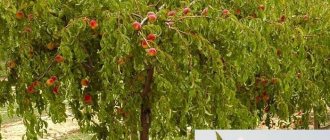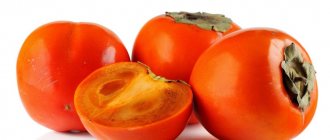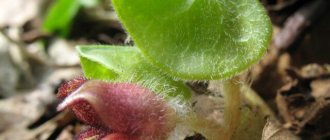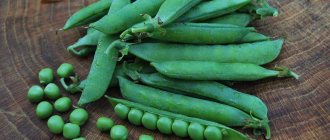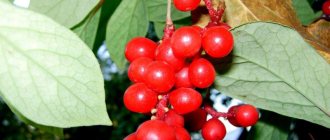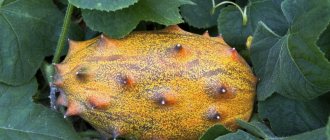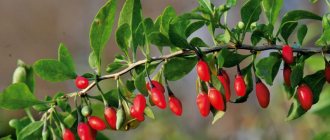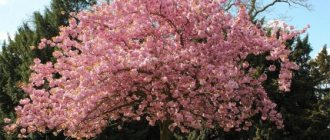What kind of fruit is loquat?
Murshmula is an exotic fruit tree that produces fruits similar to large apricots or pears.
The plant belongs to the Rosaceae family and is a relative of pear and quince. The tree reaches a height of 6 to 9 meters. The trunk is covered with gray bark with small thorns. The leaf blades are oval, large - up to 25 cm in length. Flowers with five petals, white or pink, with a pronounced pleasant aroma. The flowering period corresponds to the calendar autumn. In winter and spring, yellow or orange fruits are formed.
Medlar
Calories 47 Kcal
- Fat:
0.2 g - Proteins:
0.43 g - Carbohydrates:
12.14 g - Water:
86.73 g - Ash:
0.5 g
Medlar fruits are rich in valuable acids, macro and microelements, and vitamins. It has been established that 100 grams of fruit contains:
| Vitamins | Quantity | % of RDN |
| Beta carotene | 2.3 mg | 46% |
| Vitamin A (retinol) | 76 mcg | 8,4% |
| Vitamin B6 (pyridoxine) | 0.1 mg | 7,7% |
| Vitamin B9 (folic acid) | 14.0 mcg | 3,5% |
| Vitamin B2 (riboflavin) | 32 mcg | 1,8% |
| Vitamin B1 (thiamine) | 24 mcg | 1,6% |
| Vitamin C (ascorbic acid) | 1.0 mg | 1,1% |
| Minerals | Quantity | % of RDN |
| Manganese | 0.1 mg | 6,4% |
| Potassium | 266.0 mg | 5,7% |
| Copper | 0.06 mg | 4,4% |
| Phosphorus | 27.0 mg | 3,9% |
| Magnesium | 13.0 mg | 3,3% |
| Iron | 0.3 mg | 2,8% |
| Calcium | 16.0 mg | 1,6% |
| Selenium | 0.6 mcg | 1,1% |
The same volume of fruit contains 2.5 grams of dietary fiber and 18.09 grams of carbohydrates. Energy value - 45 kcal.
Orange fruit contains pectin, a fiber that can cleanse the body, as well as antioxidants, active elements that act against free radicals. Because of this, medlar is recommended for the prevention of cancer.
Adherents of Chinese medicine still use all parts of the medlar to prepare medicines that are effective against:
- Improving the functioning of the circulatory system.
- Kidney diseases.
- Prevention of cancer of various localizations.
- Preventing the development of diabetes.
- Hypertension.
- Losing body weight.
- Restoration of respiratory functions;
- Reducing cholesterol levels.
- Stimulation of the body's defenses.
- Normalization of digestion.
- Improved vision;
- Mineralization of the osteoarticular apparatus.
In cosmetology, medlar has become widespread due to its calming properties. Masks with plant extract eliminate redness, refresh the skin, and restore its elasticity. Essential oils are used for cosmetic wraps. An extract from the leaves is used in perfumery. In pharmacology, loquat extract is used for the production of anti-inflammatory, analgesic, antitussive, mucolytic drugs, and inhalation agents for the treatment of chronic diseases of the respiratory system.
Despite all the benefits, medlar can be harmful. Orange fruit is contraindicated in the last three months of pregnancy. It is not given to young children due to the high risk of allergies. Loquat seeds contain dangerous alkaloids that can cause breathing problems, nausea and vomiting.
How to use medlar
Medlar, whose beneficial properties and contraindications make it possible to use it not only in cooking, but also in medicine, is an excellent cure for many diseases. In folk medicine, it has long established itself as a storehouse of vitamins and minerals. And medicines based on it are not inferior in effectiveness to pharmaceutical drugs.
An infusion is prepared from the leaves to stop bleeding, diarrhea, and help with inflammation of the respiratory tract. To do this, pour one tablespoon of leaves into a liter of boiling water, strain and consume after meals. And, if you drink it twenty minutes before a meal, the infusion will cleanse the body of toxins and normalize intestinal function. If you want to fix it, you need to prepare a concentrated decoction: a tablespoon of leaves per 200 g of boiling water and drink three tablespoons twenty minutes before meals until the condition improves.
The benefits of medlar are also evident in the seeds. They contain toxic substances, which is why they are used in processed form. They are fried, dried and ground, preparing a kind of coffee drink. It is recommended for people suffering from cardiovascular diseases. For bronchitis or asthma, the bones are infused in alcohol for three days; for this, take five pieces of medlar, 100 g of alcohol and three tablespoons of honey. Take one glass of tincture daily before meals and can help with heart problems.
A decoction of medlar seeds helps with gastrointestinal disorders. Bones - two tablespoons, pour 500 ml of water and cook for twenty minutes. After this, the broth is cooled, filtered and taken half a glass in the morning on an empty stomach.
For diabetes mellitus, the beneficial properties of medlar help increase insulin levels. It can be consumed fresh or heat-treated, but without adding sugar.
A diet based on medlar has also been developed, but if you decide to do it, remember that you cannot eat more than one kilogram of fruit per day. The principle of the diet is to remove waste and toxins from the body, have a laxative effect and normalize the functioning of the gastrointestinal tract. The fruit will strengthen the intestines and saturate the body with vitamins and microelements. The essence of the diet is to carry out a fasting day, while observing the drinking regime; in addition to medlar, fermented milk products, green tea, and other fruits are added to the diet.
In addition, the fruits are tasty fresh, boiled, baked and do not lose their valuable qualities after heat treatment, this is the great benefit of medlar. The fruit is used to make excellent preserves, jams, desserts, and marmalade. Compotes and fruit drinks are prepared and added as filling to pies.
Where does medlar grow?
In the Caucasus, the first mentions of medlar date back to the beginning of the first millennium BC. In Greece, the crop has been grown since the 4th century. The subtropical fruit plant grows in the form of trees or shrubs on the Crimean Peninsula, South Ossetia, Armenia, Azerbaijan, Georgia, the Balkans, the vast expanses of Anatolia and Iran. European gardeners liked the German variety of medlar.
The medlar became most widespread in the Middle Ages. Over time, the culture was replaced by other plants that were brought to Europe from all over the world. Modern gardeners grow it extremely rarely.
Composition and calorie content
The benefits of medlar are hidden in its composition - the pulp of the fruit is filled with the most essential vitamins for human health. By eating a few berries, you can get in large quantities:
- vitamin P and PP;
- vitamin C;
- vitamin A;
- trace elements sodium and potassium.
The fruits of the plant also contain natural sugar, pectins, and natural fruit acids.
The energy value is very low - 100 g of delicious Japanese medlar fruit contains only 47 calories. Nutritional beneficial properties are represented mainly by carbohydrates, of which there are more than 10 g in medlar. Proteins and fats occupy small proportions - 0.43 g and 0.2 g, respectively.
Contraindications
Ripe medlar fruits are safe, however, like any exotic fruit, it can cause an allergic reaction. In order to understand whether the body can tolerate medlar, you need to eat 1-2 fruits and observe your own condition. If the body does not react with negative symptoms within 30-60 minutes, then the fruit can be consumed without fear.
Fresh medlar fruits are contraindicated for certain diseases:
- Gastritis.
- Chronic ulcers of the digestive system.
- Pancreatitis.
- Cholecystitis.
- High acidity of gastric juice.
Fresh fruits are not recommended for pregnant women and children under three years of age. Processed fruits are safe and retain all their beneficial qualities.
Harm and contraindications
For most people, the fruit has only benefits. But it also has contraindications.
- Eating exotic fruits is not recommended for chronic stomach problems - ulcers, gastritis, pancreatic diseases. Like many other fruits, medlar is highly acidic and can cause flare-ups.
- Before eating the fruit, you need to make sure that it does not cause allergies. They check this in the standard way - they literally try 1-2 berries and wait several hours, observing the body’s reaction.
Attention! The fruit will be harmful even in the absence of contraindications if you eat too much of the fruit. The average daily norm for an adult is only 5–6 pieces.
What edible varieties are there?
In nature, there are about thirty varieties of medlar. Of all this variety, the edible ones are:
- Champagne. The fruits are pear-shaped, covered with light down, dark yellow in color. Each berry weighs about 50 grams. The variety is characterized by a sweet taste with a slight sour aftertaste, similar to pear or cherry.
- Komun . The fruits of the variety are round and flattened. The skin is bright yellow, with fluff. The fruit pulp is juicy, with a pronounced sweet taste.
- Premier. The fruits of the tree are small, oval, yellow-orange, matte in color. The variety is characterized by a delicate sweet and sour taste.
- Tanaka . One of the types of Japanese medlar. The variety is characterized by large, pear-shaped berries, weighing up to 80 grams. The color of the fruit is yellow-orange. The taste is sweet with slight sourness.
- Morozko. The fruit is characterized by a brown-red color. The berries are large, juicy, fragrant.
The most common are German and Japanese varieties of medlar. The German variety is known to gardeners as Caucasian or ordinary. The plant loves a dry, sunny climate with mild winters and moderate summers. In the French colonies, medlar was used as an ornamental garden plant. The fruits are small - from 2 to 3 cm, dense. The taste of the berries is sour.
Japanese medlar is a tree with a dense crown and large leaves. The culture grows well in sunny or shaded areas. The variety is resistant to short-term frosts, but after severe winters it does not produce a harvest.
To understand the difference between the two most common varieties of medlar, you can look at the comparison table.
| Index | Loquat japonica | Medlar |
| Fruit skin | Soft, bright yellow | Dense, brownish or brown |
| Formation of the ovary | On young stems | On last year's branches |
| Foliage | All year round | Seasonal |
| Leaf plate | Evergreen, lower surface with fluff | Shiny, smooth, changes color to red before falling off |
| Fruit ripening | April May | At the end of autumn |
| Bones | From 1 to 5 | From 4 to 5 |
| Taste of berries | sweet | Sour, tart |
| Pulp | Juicy, soft | Dense, not juicy |
| Frost resistance | Significant | Unexpressed |
Types and varieties
Of the existing three types of medlar, gardeners grow only one on their plots of land, which is usually called:
- German medlar, or;
- Crimean medlar, or;
- medlar Caucasian.
Let's look at this view in more detail.
Medlar
Do not be misled by the presence of the word “Germanic” in the name of this type of medlar. In fact, its homeland is the southern as well as the southeastern regions of the aforementioned Anatolia and the slopes of the mountains of Northern Iran. The lifespan of the German medlar is on average 50 years. This deciduous plant, in the form of a tree, reaches a height of 8 m. The trunk is straight, and the widely spreading crown is formed by curved branches. The diameter of the pure white or pink-tinged corolla is about 3 cm.
The fruits of the German medlar are characterized by an apple-shaped round shape with a diameter of 2 to 5 cm. The taste of their pulp after full ripening is associated with applesauce. Therefore, gardeners figuratively call the azgil fruit a jam on a branch, which also emits a pleasant aroma.
Related to the German medlar is the so-called. Loquat - also known as Japanese medlar.
Loquat japonica
The height of the tree reaches the same 8 m. The dense pubescence of tangled hairs gives both the inflorescences and the shoots a grayish-red tint. Japanese medlar leaves:
- oval-leathery;
- with short petioles or sessile;
- with glossy top side;
reach:
- width - eight centimeters;
- in length - twenty-five centimeters.
Flowers consisting of 5 petals, yellow or pure white, are collected in paniculate-branched inflorescences. Japanese medlar tolerates the effects of cold well, and the older the plant, the greater its frost resistance. Below are the most famous varieties of loquat (this is the common name for this species).
- Tanaka. Its pear-shaped fruits are characterized by: orange color with a yellow tint; slightly pink flesh with a sweet taste with elements of sourness.
- Silas. The fruits of the variety, similar to apricots, weigh up to 80 g.
- Morozko. The fruits lack astringency. Grown. Another possible option is growing in a small greenhouse.
- Champagne. Fruits with fleecy yellow skin and tender pulp.
Crimean medlar photo:
Medlar Caucasian cones edible photo:
How do you eat medlar?
Usually, medlar fruits are eaten fresh. They can be added to salads, oatmeal or corn flakes. Seasonings or coffee additives are prepared from dried and crushed seeds and leaves.
In cooking, medlar is used in different forms:
- Dense, not fully ripened fruits are used as a filling for pies.
- A drink is prepared from roasted seeds, which completely replaces coffee.
- The pulp is chopped and the sauce is prepared.
- You can preserve medlar fruits in syrup.
- Juicy berries make delicious drinks and wines.
Most often, medlar fruits are used for jam, jelly, and marmalade.
In Germany, medlar jam with pumpkin is very popular. To prepare the delicacy, take 1 kg of medlar, 4 tablespoons of pumpkin seeds, 300 g of sugar. The seeds are removed from the fruit. Mix the pulp with sugar and place in the microwave for 10 minutes. Next, place the container on low heat and add pumpkin seeds. Boil for about 40 minutes.
[Video] What is loquat and how is it eaten?
Useful properties of medlar
Traditional healers and scientists have discovered the benefits of medlar as a whole and its components. Pulp, fruit seeds, and leaves are used as medicinal ingredients.
Overall Impact
The vitamin and mineral set of the fruit has a beneficial effect on human health:
- Vitamins A and C strengthen the immune system, increasing the body's resistance to harmful microorganisms and infections.
- Fiber normalizes digestion. The astringent properties of tannins (especially in unripe fruits) stop diarrhea. Ripe fruits are good for constipation.
- The abundance of water in fruits cleanses the body of toxins, radionuclides and waste.
- The almost complete composition of B vitamins normalizes blood pressure and heals the heart and blood vessels.
- Carotene is good for the eyes (its content in medlar is 1500 times higher than that of carrots).
- Improves the functioning of the liver and pancreas.
- Prevention of cancer development.
The fruit is useful as a tool for strengthening reproductive health, facilitating the female cycle, increasing male potency, and insurance against prostatitis. Medlar fruits allow you to stay young longer, prevent skin aging and the appearance of early wrinkles. Ground fruit seeds, brewed with boiling water, are useful as a substitute for coffee for those who are contraindicated from caffeine. Fruit seeds are toxic, so they are used only when processed. That is, dried or fried.
What does it taste like?
Each variety of medlar has its own taste.
The Japanese variety has a sweet taste with a slight sourness. The taste of the fruit is reminiscent of quince, pear or strawberry. Some people detect notes of cherry, apricot, and passion fruit.
German medlar is characterized by a sour taste with a hint of a tart, astringent aftertaste. Gardeners say that this variety looks like an apple. Fresh fruits are practically not eaten; they are used after processing.
About the fruit
Medlar is an unusual fruit with a rare and beautiful name. There are two cultivated fruit plants: Caucasian medlar and Japanese. Despite the common name, they are so different from each other that botanists classify them as different genera of the same family Rosaceae.
The Caucasian medlar is native to South-West Asia and South-Eastern Europe. Today, this fruit is found in Georgia, Algeria, Armenia, Crimea and all other countries with the same climate.
The fruits of the Caucasian medlar are brown with a slight red tint. They can reach a diameter of up to 3 cm. The taste of these fruits is sweet and sour, slightly astringent, and to get rid of viscosity, the fruits can be treated with cold water.
How to choose?
After harvesting, the fruits are transferred to a dark, cool place. This is done to make the fruit softer. During this time they change color to brown. Eating berries do not look attractive. People perceive them as rotten and spoiled.
In the store you should choose medlar according to the following parameters:
- The fruits should be large; small fruits are not juicy and have a sour taste.
- The color of the fruit is uniform, dark spots.
- The skin is wrinkled, without damage.
Before eating, remove the skin from the medlar berries and remove all the seeds.
For better preservation, each medlar fruit is dipped in a saline solution, then dried on paper. Store the berries in the refrigerator at a temperature of 2-10ºС, but not more than 2 days. It is important to remember that you should avoid contact of the fruits with each other.
Planting German medlar
Loves illuminated places, grows up to three meters (when grown artificially), does not tolerate stagnant groundwater. The soil needs to be slightly acidic or neutral. You can get seedlings from seeds.
The seeds are kept in the cold for more than three months, before which they are placed in a solution of sulfuric acid (3%) for five hours and washed.
Before planting, the seeds are kept in warm water for a day, in the fall they are planted in the ground, covered with polyethylene, peat or sawdust. You can grow seedlings up to 30 cm high and then plant them in the garden (the soil is loose and with drainage).
Growing loquat
The crop is grown in hot, dry regions. Taking these requirements into account, medlar is grown in greenhouses and even at home.
How to grow medlar from seed at home?
You can get a plant from a seed, but it will not bear fruit soon. For germination, you can take seeds extracted from the fruit no more than three days ago. To get the result, you must perform certain manipulations:
- Prepare a soil mixture of equal parts of peat, sand, leaf soil, and humus.
- Place a layer of expanded clay in a drained pot.
- Fill the container with the prepared soil mixture.
- Deepen the seed to 2 cm. You can germinate up to 6 seeds in one pot.
- The top of the container is covered with film or glass.
- The pot is placed on a well-lit windowsill.
- The first shoots appear after 6-8 weeks, after which the pot is shaded from direct sunlight. The film is lifted daily to ventilate the sprouts and remove condensation, which can cause the development of fungi.
- The film is completely removed when the sprouts reach about 2 cm in height.
- At a temperature of +18°C, it is allowed to take the pot out into the open air, provided it is protected from active sun and drafts.
- Watering the sprout is carried out every 2-3 days.
- After about a month, the shoots reach up to 15 cm in height. At this time, they can be seated in separate containers. For planting, use the same recipe for preparing the soil mixture.
The first flowering of seedlings is observed approximately three years later at the end of autumn. The fruits will be formed by the New Year holidays. The crown is formed after the flowers fall, but this is not necessary. The tree can grow naturally; you only need to promptly remove dry, damaged or diseased branches.
[Video] How I planted 500 medlar seeds:
Growing in the garden
It is allowed to plant medlar seedlings obtained from seeds in open ground that are older than three years. In order for the plant to take root in new conditions, certain planting rules are followed:
- Select a well-drained area with slightly acidic or neutral soil.
- The place should not be flooded with groundwater more than 1.5 meters to the surface.
- A distance of at least 4-5 meters is maintained between trees.
Medlar is planted in spring or autumn - at this time the plant is dormant. The following are recommendations:
- The area allocated for planting seedlings is dug up and bone meal is added.
- A soil mixture is prepared from equal parts of leaf and plant humus, turf, and river sand.
- Dig a hole, which should be about 1/3 larger than the root of the tree along with the earthen lump.
- A fairly high peg is driven into the center of the prepared hole.
- The seedling is removed from the pot and transferred to the hole.
- The space around the tree is filled with soil mixture.
- The plant is watered abundantly.
- After the soil settles, the planted tree is tied to a peg.
Rotted manure or compost is used for mulching. The mulch is poured to a depth of 7-8 cm, avoiding contact with the trunk of the young tree.
Caring for garden medlar. The rules for caring for medlar are not much different from those that are followed for other garden trees. To get a harvest, it is important to fulfill simple requirements:
- Water the tree generously, but make sure that the soil around the trunk is not waterlogged.
- After watering or rain, be sure to loosen the soil in the circle around the trunk.
- Remove weeds in a timely manner.
- Fertilize the plant 2-3 times per season with mineral fertilizers and mullein solution. Feeding is carried out once every three weeks.
- In the spring, damaged, frozen, diseased shoots are pruned.
Young, 3-4-year-old trees need pruning of skeletal shoots at the level of 1/3 of growth from the outer bud. Branches that intertwine are trimmed, leaving up to 3 buds. After the plant has reached 4 years of age, it is pruned every year to form a crown.
Reproduction by cuttings
Vegetative propagation involves performing certain step-by-step actions:
- A cutting with two nodes, about 15-20 cm long, is cut from last year's growth.
- The upper leaves are cut to 1/3 of the length, the lower leaves are removed.
- The cut areas are generously sprinkled with fine ash.
- Expanded clay is poured onto the bottom of the pot, and a mixture of equal parts of black peat and river sand is poured.
- The cuttings are planted perpendicular to the surface of the soil mixture to a depth of no more than 4-5 cm.
- Well watered.
For quick, complete rooting, the cuttings are regularly watered and sprayed with boiled water. After the root system has formed, the seedling is planted in the garden. Proper care ensures active growth and development of the plant.
Diseases and pests
Medlar is a fairly resistant tree to parasites and phytoinfections. This quality is preserved both in the garden and during single planting. Caterpillars that actively eat leaves can pose a danger to the crown. To avoid their reproduction, all spider nests are carefully collected from the branches and be sure to be burned.
During the period when the first young leaves appear on the medlar, it and the adjacent area of the soil are treated with one of the solutions:
- Insecticide Chlorophos - 3%.
- Fungicide Nitrafen - 3%.
- Insectoacaricide Karbofos - 7%.
For preventive purposes, trees are sprayed in early spring and autumn, when their foliage has completely fallen.
To prevent the appearance of pests, prepare one of the recommended means:
- Bioinsecticide Lepidocide - 25 g per 10 liters of water.
- Insecticide Insegar - 5 g per 10 liters of water.
- Insectoacaricide Fitoverm - 20 g per 10 liters of water.
Despite the small dosage, the solutions are quite concentrated. Working with them must adhere to certain safety rules.
When to harvest the first harvest?
The time to harvest medlar depends on the variety grown and climatic conditions. In any case, choose medium-sized fruits, soft, without darkening on the skin. To prepare medicines, medlar leaves are harvested in August.
Japanese medlar ripens, for example, in Turkey and the southern states of America it ripens in late March-early April, on the Black Sea coast - in May, on the Southern Coast of Crimea - in mid-summer. The fruits are harvested only after ripening. Unripe fruits do not have the ability to reach a certain condition. The harvested crop is stored in the refrigerator for 3-4 days.
The fruits of the German medlar are harvested after the first frost. The berries become soft and ready to eat. In case of a warm winter, medlar is collected at the end of November or December, filled with salt water and placed in a cool place. After a couple of weeks, the fruits become a little smaller, their skin wrinkles, but the flesh becomes more tender and acquires a pleasant sweet and sour taste.
Recipes with loquat
Loquat jelly from pastry chef David Lebovitz from California, USA
To prepare approximately 2 liter jars of jelly you need:
- 1.5 kg of ripe German medlar
- 1 large green sweet and sour apple
- half a lemon + a little for taste
- 2 liters of drinking water
- 600 g sugar
- Cut the whole medlar into 4 pieces without peeling. Cut the apple, also without peeling, into 6-8 pieces. Cut the lemon into 2 parts lengthwise. Place all prepared ingredients in a saucepan with a thick bottom and add water. It should completely cover the contents and the ingredients should float in it.
- Bring the contents of the pan to a boil over medium heat. Reduce heat and simmer at low simmer for 40-45 minutes.
- Line a colander with several layers of gauze. Place a colander in a deep bowl and pour the contents of the pan. Cover the colander with gauze and leave for 6-8 hours. There is no need to crush the sweet mass, otherwise the jelly will be cloudy.
- Pour the liquid into a large saucepan. It should be about 1 liter. Place a small saucer in the freezer.
- Add sugar to the pan and cook over low heat until the mixture becomes jelly-like. The temperature of the jelly will be approximately 104-105 °C. To check the readiness of the jelly, scoop the mixture with a tablespoon. Place a spoon on a plate in the freezer and leave for 2-4 minutes. Take out a spoon and press your finger into the jelly. If it wrinkles, it means it's ready. If not, continue cooking the jelly until it becomes jelly-like.
- When the jelly is ready, you can offset the sweetness with a few drops of lemon juice if you wish. The jelly is ready. Remove from heat and pour into clean jars. This jelly can be stored in the refrigerator for exactly 3-4 months.
Loquat Pie
To prepare a pie for 6 servings you need:
- 100 g whole grain flour
- 100g all-purpose flour (general purpose)
- 100 g softened butter
- 120 ml cold water
- 500 g whole medlar
- 40-50 g honey or 70 g cut into pieces honeycomb with honey
- zest and juice of 1 juicy orange
- 40 ml cream 22% fat
- 1 egg
- ½ tsp. apple pie spices
- salt on the tip of a knife
- Mix flour in a bowl. Add softened butter and mix with flour with a fork until fine crumbs form.
- Add ice water and stir. Form into a ball. If the mixture is dry, add a few more drops of water. Cover the dough with a towel and leave for 15 minutes. at room temperature.
- Roll out the dough into a round layer, 4-5 mm thick. Place in a heat-resistant round mold 2-3 cm smaller than the diameter of the layer. Form the sides. Line the dough with baking paper, pour in beans or peas (a layer of at least 2 cm). Bake in an oven preheated to 180°C for 15-20 minutes. Remove pan from oven and remove weights and paper.
- Peel the medlar, remove the seeds, and chop coarsely. Mix with honey, juice and orange zest. Add cream and egg, beaten until smooth with spices and salt. Stir.
- Place the filling in the prepared dough “basket”. Level and bake for 45-55 minutes. Serve the pie hot or cold.
How much does it cost in Russian stores?
Despite the fact that medlar is found in the Russian Federation, it is almost impossible to buy it in grocery stores. Exotic fruits are offered by online stores that deliver products to your home.
One kilogram of medlar grown in Russia costs about 310 rubles. A Premier tree seedling that has reached 3-4 years of age will cost 1,500 rubles. If you want to try medlar, canned in syrup, made in China, prepare 180 rubles for a jar weighing 567 grams.
Medlar is an amazingly beautiful evergreen tree that will decorate any garden. Proper care and timely fertilizing with mineral and organic fertilizers will help you get a good harvest of healthy fruits.
How to grow
Loquats like neutral, well-drained soil. There are several ways to grow a tree:
- From a seedling. This is the best option for growing exotic fruit. Drainage along with complex fertilizer is also placed in a hole corresponding to the size of the seedling, and everything is covered with peat substrate on top.
- From a seed. Only those seeds that sink to the bottom when placed in a jar of water are suitable for successful cultivation. They must first be soaked for a day in water, and then placed in a substrate for flowering plants to a depth of 3-4 cm and covered with film, not forgetting about daily ventilation. About 5 seeds can be planted in a 1.5-2 liter pot. When the height of the seedlings reaches 3 cm, plant them in individual containers and transfer them to open ground in the spring.
- From a cutting. Suitable for cultivation are shoots of last year's growth with two formed nodes and a height of at least 20 cm. Partially remove the leaves from them, sprinkle the cuttings with ash and plant one at a time in pots with a bulk layer of drainage and soil in the form of a mixture of sand and peat (1:1) . Further, periodic spraying and watering is required as the soil dries out. Forming a dome made of transparent material over the pot will help create more comfortable conditions. Cuttings usually take root after a month, but noticeable growth is not observed for a long time, since the root system is actively forming.
Subsequent care is practically no different from the procedures required for most fruit and berry crops:
- Moderate watering, without waterlogging the soil.
- Application of complex fertilizers: for young seedlings - every 3-4 weeks, for mature trees - three times a year.
- Crown formation. To get a plant with a voluminous, lush crown, you need to regularly pinch the foliage.
- Timely pruning of damaged, dry shoots.
- Treatment with pest control agents (aphids, scale insects, scale insects).
Both the German and Japanese varieties can be grown in indoor or greenhouse conditions. Despite the fact that the tree can grow up to two meters, it will feel comfortable in an apartment if it is timely pruned and transplanted into a larger pot. If you plan to subsequently replant in open ground, it is better to choose the first option, as it is more adapted to a temperate climate.
Room temperature
Medlar is a tropical plant, so the indicators must be appropriate. The optimal numbers are 20 – 250 C. When growing indoors, you must ensure that the thermometer does not fall below 150 C. In the warm season, it is recommended to take the pot out into the fresh air. This could be a balcony or terrace. In winter, the tree is kept on the windowsill or away from the window. In the second case, installation of additional lighting is required.
Watering
There is no need to water the chinese tree in winter, but the soil should not be allowed to dry out completely.
The watering schedule for an adult plant depends on the season: in winter - twice a week, in summer - more often, depending on the rate of moisture evaporation. It is recommended to cover the soil surface with a layer of moss to prevent rapid drying.
It is best to water with settled, clean water slightly warmer than the room temperature. It is not recommended to spray the plant due to the pubescence of the crown. To remove dust from the foliage, you can wash the tree in the shower once a month.
If ezgil overwinters on the balcony, then watering should be stopped completely until the ambient temperature increases. From time to time, a pot of Japanese winterflower should be placed on a mat with moss, expanded clay or small pebbles.
Top dressing
Regular fertilizers for ornamental plants are suitable for feeding the cone plant.
The cup tree responds well to fertilizing, which is best done in the off-season: in spring or autumn with an infusion of organic fertilizers. One of the acceptable feeding options is an infusion of cow manure in a ratio of 1 to 10 with water. The decorative properties of eriobothrya can be improved by adding a little crushed dried plaster to the soil.
During the flowering period, phosphorus fertilizers should be used, and potassium fertilizing should be postponed during active growth.
Young plants are fertilized once a month, adults – three times during one season. In winter and at rest, Eriobothrya is not fed. Once a week, the top layer of soil is loosened, providing oxygen access to the roots.
Irrigation
Watering the crop directly depends on the season. In the summer, when it is hot outside, the tree needs to be irrigated frequently and abundantly. The soil should always be slightly moist. Winter is a dormant period for the tree. Therefore, the procedure must be carried out to a minimum, while ensuring that the earthen lump does not dry out completely. Water for irrigation should be taken only at room temperature. It is recommended to let the liquid sit well before use.
To ensure that air penetrates well to the roots, the top of the soil should be loosened once a week.
Trimming
It is necessary in order to form a beautiful bush. Using scissors, you need to periodically remove the tops of the shoots. To speed up their growth, you will need to cut off the peak part of the plant. This significantly activates the growth of lateral branches.
Medlar: what is it - a description of the oldest fruit
The plant is similar to quince, but smaller in size. In the wild, it produces rosehip-like fruits. With good care, gardeners grow larger specimens (5-8 cm in size) of better quality. They are red-brown in color, with unfolded sepals. Inside there are 4-5 seeds, protected by a hard “box”.
Caucasian medlar is winter-hardy, easily withstands frosts down to minus 30 degrees, but prefers sunny, dry places and slightly acidic soils. Blooms in May. The harvest ripens in November, following feijoa.
The Caucasian variety is distinguished by moderate hardness, tart, sour taste, and an astringent aftertaste. After the first frost, the fruit becomes sweeter and acquires a creamy texture with a taste of apple jam. As soon as softening begins, the surface becomes wrinkled and dark brown.
The fruit, ready to eat, looks spoiled inside and out. This may be confusing to those who are not aware of its features. The taste is complex. It reminds me of something between a date and a cherry.
Ripe berries are removed carefully so as not to damage them. They burst even with a light touch. It is much more convenient to collect unripe medlar. It is laid out on a napkin in a dark place. At room temperature it arrives in 3-5 days. As it ripens, it is ground with sugar. It is used to make a sweet puree that goes perfectly with pancakes and pancakes. Often medlar is mixed with hawthorn or viburnum.
Caucasian medlar is eaten even fresh. To do this, wash it, remove the stalk, and carefully squeeze out the inside. The bones are removed.
Fruits are put into tea, added to cottage cheese or mixed with natural yogurt. They are used to make marshmallows, jelly, marmalade, compote and jam.
Medlar in cooking
The product, previously used only in oriental cuisine, migrated to national dishes of European cuisine. How do you eat medlar? Due to the prevalence of the exotic fruit only in the southern territory of Russia, this question interests many.
The medlar fruit is consumed both fresh and used for cooking compotes, juices, and jelly. It makes excellent jam, which has a lot of useful properties. Its moderate consumption helps strengthen the immune system.
In combination with garlic and red pepper, the fruits of the plant are used to prepare gravy for meat dishes. The fruit goes well with all types of meat.
In Spain, medlar salad with tangerine is popular. To prepare it, you need to beat 2 eggs until a thick foam forms, add 3 tbsp. l. lemon and a glass of pineapple juice, 2 tbsp. l. sugar, 1/4 tsp. salt and 1 tsp. olive oil. Heat the resulting mixture over heat until thickened. In a salad bowl, mix 200 g of boiled pasta, 500 g of chopped pineapples, 350 g of tangerines, 200 g of finely chopped green grapes, 200 g of chopped medlar fruits. Pour the prepared mixture over the fruit and add whipped cream to taste.
You can make delicious fruit kvass from the fruits of the plant. To prepare it correctly, you need to dilute 400 ml of medlar juice with 4 liters of boiled water, add 1 glass of sugar or honey, 20 g of yeast, leave for 24 hours. The resulting drink is consumed cold.
Use in cosmetology
Due to the high content of fruit acids (AHA) the exotic fruit is effectively used in the field of cosmetology. AHA acids ensure exfoliation of dead skin cells, helping to nourish and oxygenate the skin. Peelings, the component of which is an extract of the fruits of an exotic plant, perform the following functions:
- smoothing skin texture;
- increasing its elasticity;
- eliminating pigment spots and brightening skin tone;
- reducing the number of facial wrinkles;
- elimination of post-acne marks;
- strengthening of metabolic processes inside cells.
The fruits of the exotic fruit are included in many acid creams and tonics used for various skin types. For oily skin, their use helps cleanse pores of impurities and normalize the functioning of the sebaceous glands. By acting on dry skin, the fruit acids contained in medlar enhance its ability to absorb and retain water.
At home, you can prepare a cleansing lotion based on exotic fruit juice and rice vodka (in a 1:2 ratio), the use of which promotes skin cell renewal.
German medlar is harvested in late autumn and kept until it is fully ripe

